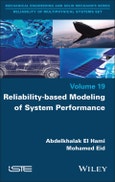Probabilistic modeling of system performance, built primarily on the foundation of reliability theory, is referred to as reliability-based modeling.
This book progressively builds up the functional complexity of system modeling. It starts by modeling the simplest system that can be designed, and then moves to the functional modeling of the multi-state system, step-by-step.
Reliability-based Modeling of System Performance deals with modeling the functioning of systems by presenting its concepts, methods and mathematical tools. It is accessible to engineering students and academics who have already acquired basic knowledge of probability theory, applied statistics, differential calculus, integrals, combinatorial calculus and Boolean algebra.
Table of Contents
Introduction ix
Chapter 1 Basic Notions 1
1.1 Introduction 1
1.2 Logical notions 2
1.2.1 Axioms 3
1.2.2 Elementary laws 5
1.3 Probabilistic notions 5
1.3.1 Probability D(t) and probability density ρ(t) 5
1.3.2 Failure occurrence rate λ(t) 6
1.3.3 Independent random events 7
1.4 System functional description 8
1.5 Binary system and basic model 10
1.6 The availability of binary systems 11
1.7 The sojourn probabilities 15
1.7.1 Reliability model 15
1.7.2 Maintainability 17
1.8 Failure, repair and stochastic processes 19
1.8.1 Renewable stochastic processes 20
1.8.2 Conditionally renewable stochastic processes 22
1.9 Multistate system 24
Chapter 2 Modeling of Multistate Systems 27
2.1 Systems with analytical representation 28
2.2 Critical transitions 32
2.3 Binarization of multistate systems 32
2.4 Failure-to-start probability 37
2.5 Forbidden transitions 37
2.6 Boolean models and state graphs equivalence 39
2.7 Systems with systemic structure representation 41
2.8 The Markov graph 43
Chapter 3 Matrix-like System 47
3.1 Introduction 47
3.2 Modeling the functional state of the system 48
3.2.1 Modeling a line of elementary components 49
3.2.2 System functional space modeling 49
3.2.3 The subspaces of sets 56
3.2.4 Transitions between sets 57
3.2.5 Modeling of equivalent rates of transitions 58
3.2.6 Dynamic modeling of operating states 61
3.3 Homogeneous matrix-like system 62
3.4 Academic case 64
3.4.1 Case specifications 64
3.4.2 Determine system performance 65
3.4.3 Results 65
3.5 Conclusion 65
Chapter 4 Modeling of Systems with Redundancy 69
4.1 Introduction 69
4.2 Combinatorial analysis of the n/N system 70
4.3 Determining the availability/unavailability 71
4.3.1 Analysis by the binary structure function 71
4.3.2 Analysis by Boolean expressions 72
4.3.3 Example of analysis using Boolean expressions 75
4.4 The equivalent failure and repair rates 77
4.5 Homogeneous system 79
4.5.1 Characterization of the homogeneous system 79
4.6 Numerical application (1) 80
4.7 Numerical application (2) 82
4.7.1 Mission success criteria and system data 82
4.7.2 Functional modeling by state graph 82
4.7.3 System availability modeling 83
4.7.4 Modeling system unavailability 85
4.7.5 Modeling the equivalent failure rate of the system 86
4.7.6 The mean time before detection 87
4.7.7 Redundancy effectiveness assessment 88
Chapter 5 System Reliability -- Application 91
5.1 Description of the system 92
5.2 System missions 93
5.3 Basic data 93
5.4 System unavailability modeling 94
5.5 System unavailability assessment 96
5.6 System availability modeling 98
5.7 System availability assessment 99
5.8 Reliability modeling 100
5.9 System reliability assessment 104
5.10 Analysis of the relative importance of components 105
5.10.1 The predictive importance index 105
5.10.2 The operational importance index 107
5.11 Conclusion 111
Chapter 6 Sequential Events -- Modeling and Analysis 113
6.1 Introduction 113
6.2 Sequential analysis with variable time intervals 116
6.3 Sequential analysis with fixed time intervals 122
6.4 Conclusion 124
Chapter 7 The Monte Carlo Simulation Method 125
7.1 Generation of random variables 125
7.2 Sampling 127
7.3 Analytical bijective sampling 127
7.4 Generic Monte Carlo simulation approach 130
7.5 Simulation of transitions in a multistate system 132
7.5.1 The transition simulation approach 134
7.5.2 Transitions simulation algorithm 135
7.5.3 Transition histogram simulation results 136
7.5.4 The number of sojourns by state 139
7.5.5 Sojourn time by state 140
7.5.6 The failure probability 141
7.6 Simulation of the operation of a redundant system 143
7.6.1 System description 144
7.6.2 Operation histogram generation algorithm 144
7.6.3 Operation histogram 146
7.6.4 The mean time to fail 147
7.6.5 Algorithm for determining system reliability 149
7.6.6 System reliability estimation 150
7.7 Conclusion 151
Chapter 8 Physical Tests used in Reliability 153
8.1 Introduction 153
8.2 Accelerated tests 155
8.2.1 The different acceleration laws 156
8.3 Simple mechanical fatigue, Wöhler model 159
8.3.1 Empirical laws of fatigue 161
8.4 Aggravated tests 162
8.4.1 The main aggravated tests 163
8.5 Bayesian tests 172
8.6 Fatigue damage analysis 173
8.6.1 Formulations and development 173
8.6.2 Fatigue damage 176
8.7 Methodology of improvement using physical tests 178
8.7.1 Optimization of the physical tests to be carried out 178
8.8 Conclusion 182
Appendix: Common Reliability Modeling Laws 185
References 191
Index 195








